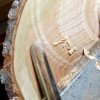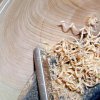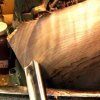I know this has been addressed before, some how I just can't get it right.
I'm turning wet Cherry natural edge bowls and can't stop tearing the end grain. I am using a 1/2 inch bowl gouge with a finger nail grind. Yes it's sharp and honed. I've tried cutting up hill and down. I have used the gouge as a shear scraper. I have tried these techniques after saturating the wood with Deft thinned 50/50 with laquer thinner and letting it dry. HELP.
jwavem :mad:
I'm turning wet Cherry natural edge bowls and can't stop tearing the end grain. I am using a 1/2 inch bowl gouge with a finger nail grind. Yes it's sharp and honed. I've tried cutting up hill and down. I have used the gouge as a shear scraper. I have tried these techniques after saturating the wood with Deft thinned 50/50 with laquer thinner and letting it dry. HELP.
jwavem :mad:



